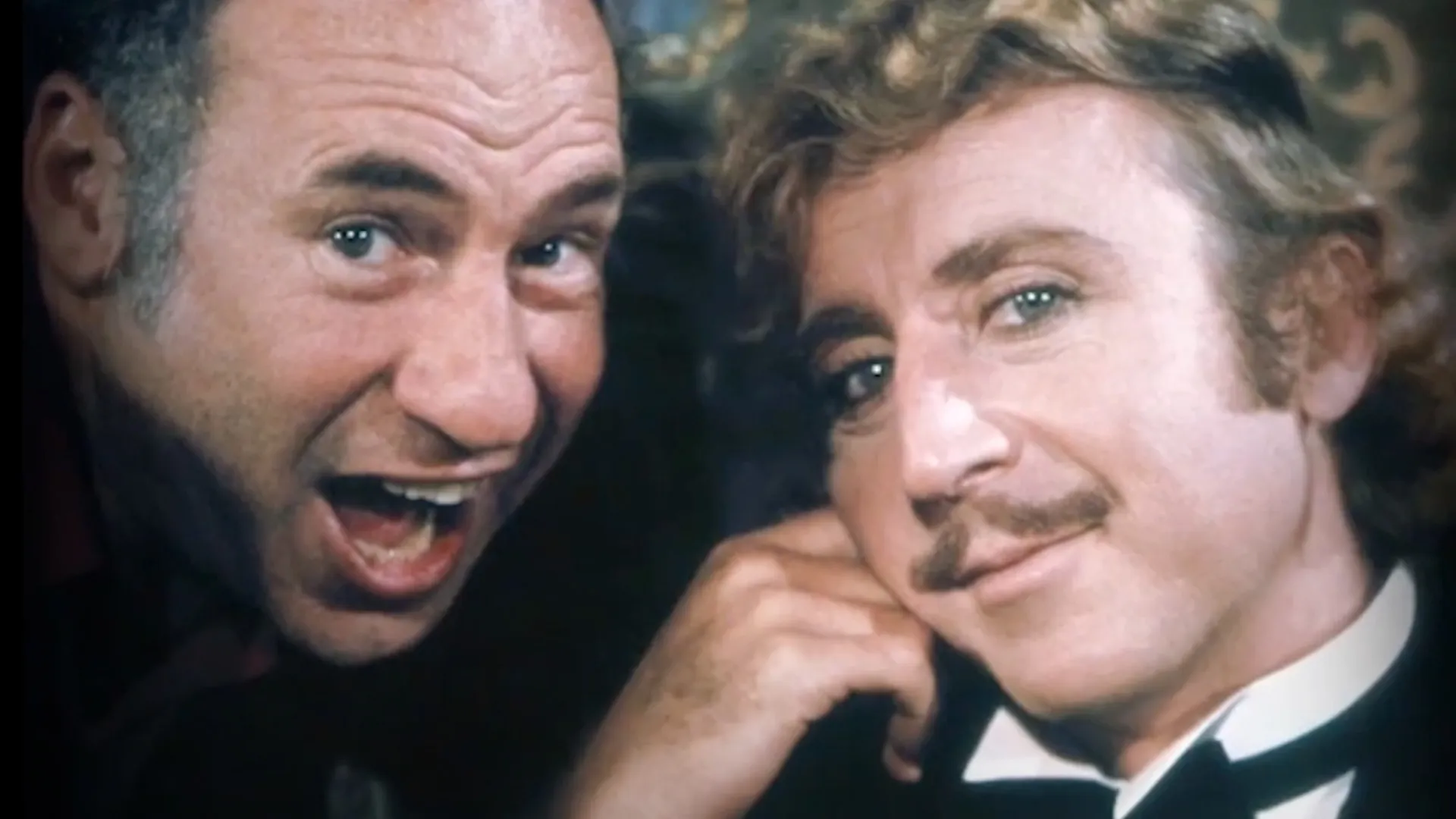There was something truly special about Gene Wilder. Though he left us years ago now, those who loved his work still feel his magic. For many, Wilder remains the undisputed champion of Willy Wonka, the mad hatter bringing wonder and whimsy to Roald Dahl’s beloved story like no other.
But Willy Wonka was really just one piece of the puzzle. Working alongside friend and collaborator Mel Brooks, Wilder starred in some of the funniest movies ever made. The Producers, Blazing Saddles, Young Frankenstein—even today, they have the power to leave audiences in stitches.
Whether balancing pathos with his perfect comedic timing or improvising unexpectedly off-script, Wilder displayed unique gifts. Beyond Brooks, he found further success partnering with Richard Pryor in films like Silver Streak and Stir Crazy. Yet Wilder was more than just a funny man.
Under the laughter lay a creative soul of depth and empathy. This new documentary, Remembering Gene Wilder, pays tribute to not only the artist but also the man. Through interviews and Wilder reflecting in his own voice, it shares memories of those who knew him best. In so doing, it honors Wilder’s legacy while offering new insight into what drove one of comedy’s true originals.
Remembering the Comedy Legend
This documentary paying tribute to Gene Wilder is crafted with love and care. We see snippets of Wilder himself, hearing his soothing voice reflect on a life dedicated to spreading joy. From those early days of discovering his gift for performance, audiences could sense they were in for something special.
The film takes a chronological approach, utilizing interviews with those who knew Wilder best. We hear from his lifelong friend and collaborator, Mel Brooks. Their chemistry was magic, producing enduring classics like The Producers, Blazing Saddles, and Young Frankenstein. Brooks provides intimate anecdotes of their partnership with humor and heart. Wilder’s wives past and present also offer perspective, sharing his caring nature.
Wilder had a magical way of blending gravitas with goofiness that made even the most preposterous plots thoroughly believable. Whether directing his own quirky visions or lending support to Richard Pryor’s side-splitting antics, he spared no chance to challenge himself. Yet amid the laughter were also heavy burdens, from losing her first love, Gilda Radner, and other dear friends. Their memories live on in his work.
As the documentary progresses, clips and commentary paint the portrait of an artist who is always growing. Later, we see Wilder step behind the camera, showing his range with offbeat gems like The World’s Greatest Lover. While some projects struck gold more than others, Wilder’s enthusiasm and effort never ceased inspiring those around him.
This film is a heartening reminder that even amid life’s complexities, one person’s genuine spirit can brighten the world. By fondly looking back on Wilder’s incredible body of work and the joy he offered, his light shines as brightly as ever.
Jerome Silberman’s Journey to Stardom
Jerome Silberman’s path to screen legend Gene Wilder began in Milwaukee during troubled times. Born in 1933, he came of age caring for his mother after she suffered a heart attack. Such responsibilities shaped the soft-spoken yet mischievous boy who found escape in the theater. By his twenties, Jerome had emerged on stages from Cambridge to Broadway, honing his craft.
It was on those boards that he’d meet talents who changed his life. In the 1960s, Anne Bancroft introduced her love, Mel Brooks, to Jerome’s work. Brooks saw promise in the gangly character actor and knew he’d found the perfect Leo Bloom for his satire “The Producers.” Jerome took the role, debuting a new screen name: Gene Wilder. Opposite Zero Mostel, Wilder lit up screens with his timid yet dreamy accountant, ready to con the world.
With the 1968 film’s success, new doors opened. Wilder joined icons like Warren Beatty for the generation-defining crime epic “Bonnie and Clyde.” Playing Eugene, Wilder added layers to this small but pivotal part. Then came a role no actor has since touched—Willy Wonka. Wilder vanished into a reclusive chocolatier, as Roald Dahl envisioned, playful yet mysterious. He made an eccentric soul both unnerving and empathetic, pioneering a brand of quiet weirdness that fueled future quirky roles.
These early works set Wilder on a path, unraveling all we think we know. Behind nervous facades hid minds aflame with mischief. Such roles as controlled chaos became his expertise, blending unease and elation in ways viewers still savor. All started because a young talent found shelter in stories, and stars like Brooks saw beyond awkward exteriors, uncovering the magic within. From those building blocks, a legend and the laughter of millions emerged.
Creative Chaos With A Comedy Companion
Mel Brooks found an unmatched partner in hilarity with Gene Wilder. Their bonds of trust let masterworks thrive where madness might have wrecked others. From breakthrough roles in The Producers to genre-defining adventures, the pair pushed boundaries with relentless verve.
It started by chance through Anne Bancroft, Brooks’ wife, who spotted Wilder on stage. She insisted her beau view this gangly talent, fueling a friendship for the ages. Brooks crafted the perfect part for Wilder’s debut: nervous accountant Leo Bloom. Opposite Zero Mostel’s scoundrel, Wilder delivered neurosis with nuance, stealing scenes through subtlety.
Success saw them reunite on Blazing Saddles, though tragedy struck. Their Waco Kid actor fell ill, and Wilder, mid-shoot for another, rushed in. As Brooks laughs, Wilder learns his character’s name minutes before cameras roll. Pure instinct guided reactions; the script was never specified. Together, they crafted comedy perfection through pressured peril.
Wilder then yearned to direct and co-write Young Frankenstein scripts. Brooks remained awed by Wilder’s precision, like demanding seventy-four takes for a single-line delivery, until perfection emerged. Together in the edit suite, sparks truly flew, fueling inspired additions on the fly. Their bonds let untamed notions fly freely, enriching every frame with frenetic flair.
Though relations outside proved stormy at times, in their element, Wilder and Brooks were symphonies. Offstage, too, deep care defined them. Even now, reminiscing melts Brooks to his core, for Wilder vanished more than a friend—comedy lost family at its finest. Their flights of fancy still send spirits soaring, a testament to creativity unleashed by compassionate chaos.
Bonds on Screen
While Gene Wilder thrilled audiences in beloved comedies with Mel Brooks, other performances proved his potency across genres. Pairing with Richard Pryor lent an unforgettable duo; their contrasting energy was the was the perfect foil for farcical fun.
Stir Crazy sparked comic fireworks as unfortunate pals tangled in capers. Sharing a kinship off-screen bonded their on-screen hijinks. Audiences flocked for frivolity, cementing their chemistry. Later collaborations showed a deeper rapport: Pryor faced trying times due to illness, and Wilder lent compassionate support.
As director, Wilder infused passion into personal projects. Young Frankenstein drew from his love of monster movies, pairing parody with plaudits. His directorial debut, The Adventure of Sherlock Holmes’ Smarter Brother, likewise blended mystery and mirth through a farcical lens.
Yet not all ventures resonated with viewers. The Frisco Kid tapped Wild Talent but missed the comedy mark for some. Yet Wilder persisted in sharing smiles and helmings like The Woman in Red, igniting box office delight through romantic romps.
Ever curious, he delved daringly into drama too. Bonnie and Clyde, Everything You Always Wanted to Know About Sex, and The Little Prince showed Wilder’s versatility, though they received mixed responses. Commercial results mattered less; spreading happiness through humor and the heart remained his main artistic drive.
Audiences rightly remember beloved highs. Yet Wilder gifted more; through varied roles and directing, he proved the power to connect lies, not in any single success but in his willingness to take chances, bringing joy to others.
Behind the Laughter
While bringing joy to audiences worldwide, Gene Wilder navigated sorrows in his personal life. He married four times, finding the deepest connection with Gilda Radner. Their bond was a meeting of kindred spirits, both possessing a passionate spirit for creativity. Together, they explored life’s wonders through a lens of humor.
Yet this joy was only briefly felt. Gilda was taken by cancer’s cruel hand, leaving Gene to face tragedy alone. Her loss rattled him profoundly. How does one recover when the other half vanishes? Work provided solace, though wounds of the heart heal slowly.
Later, a lone light appeared. On the set of See No Evil, Hear No Evil, Gene met Karen, a caring soul to soothe his own. Their union lasted decades, through the hardships of new diseases. Non-Hodgkin’s lymphoma struck, but Gene fought with fierce will. His spark brought laughter that did not dim, enriching later movies with color and wit.
Yet all things must come to an end. As the years went by, beloved friends passed on. Richard Pryor succumbed to illness, severing another important bond. And within, insidious Alzheimer’s spread its reach. Gene faced his stealing of memories and himself with quiet grace.
Through it all, one truth shined clear: Gene touched all with the gift of mirth. Till life’s finale, he remained devoted to spreading smiles. While early stardom faded, none can diminish the joyous world he left behind. His legacy lives on through films that uplift and remind us that even in life’s darkness, there can be light—if only we open our eyes to find it.
Fond Farewell to a Funnyman
Gene Wilder brought much laughter to the world, though his life also knew sadness. A creative soul from youth, he found his calling on the stage and forged pivotal bonds. Joining forces with Mel Brooks, their zany scripts lit up screens through the ’70s. Whether playing meek roles with hidden depths or eccentric characters hard to pin, Wilder made the preposterous plausible with finesse.
He crafted unique duos too, none quite like the interplay with Richard Pryor. Their movies tickled audiences, showing how disparate types can find understanding through humor. Tragically, Gilda Radner was taken too soon, yet through it all, Wilder kept that ability to lift spirits. Even as illness slowly silenced him, his works remind us that life holds treasures if we embrace each moment.
For those holding his memory dear, this film pays tribute aptly. Archival footage, interviews, and Wilder’s own insightful words weave his narrative together. Fans can look back fondly, and newcomers can get an introduction to his gifts. While there is no replacement for watching classics like Willy Wonka or Blazing Saddles, this profile celebrates Wilder’s heart, humor, and craft, granting a fitting send-off to one who spread delight with ease. His legacy is assured, thanks to a body of work that brings smiles to generations to come.
The Review
Remembering Gene Wilder
Remembering Gene Wilder offers a heartfelt homage to the legendary comic genius. With extensive archival footage and interviews from his collaborators and loved ones, the documentary paints a rich portrait of the man behind the smiles. Wilder's sly wit and gifts as an actor, writer, and director are on full display alongside the personal triumphs and tragedies he endured. Director Ron Frank has crafted a tribute that does justice to Wilder's enduring legacy.
PROS
- Features extensive archival footage and interviews that provide great insight into Wilder's career and life.
- Covers Wilder's most iconic roles and influential collaborations.
- Effectively conveys Wilder's humor, creativity, and personal struggles.
- Pays heartfelt tribute to Wilder's enduring comedy legacy.
CONS
- He could have explored some parts of his life in more depth.
- Lacks critical analysis of Wilder's body of work
- The organization jumps around between topics at times.





















































